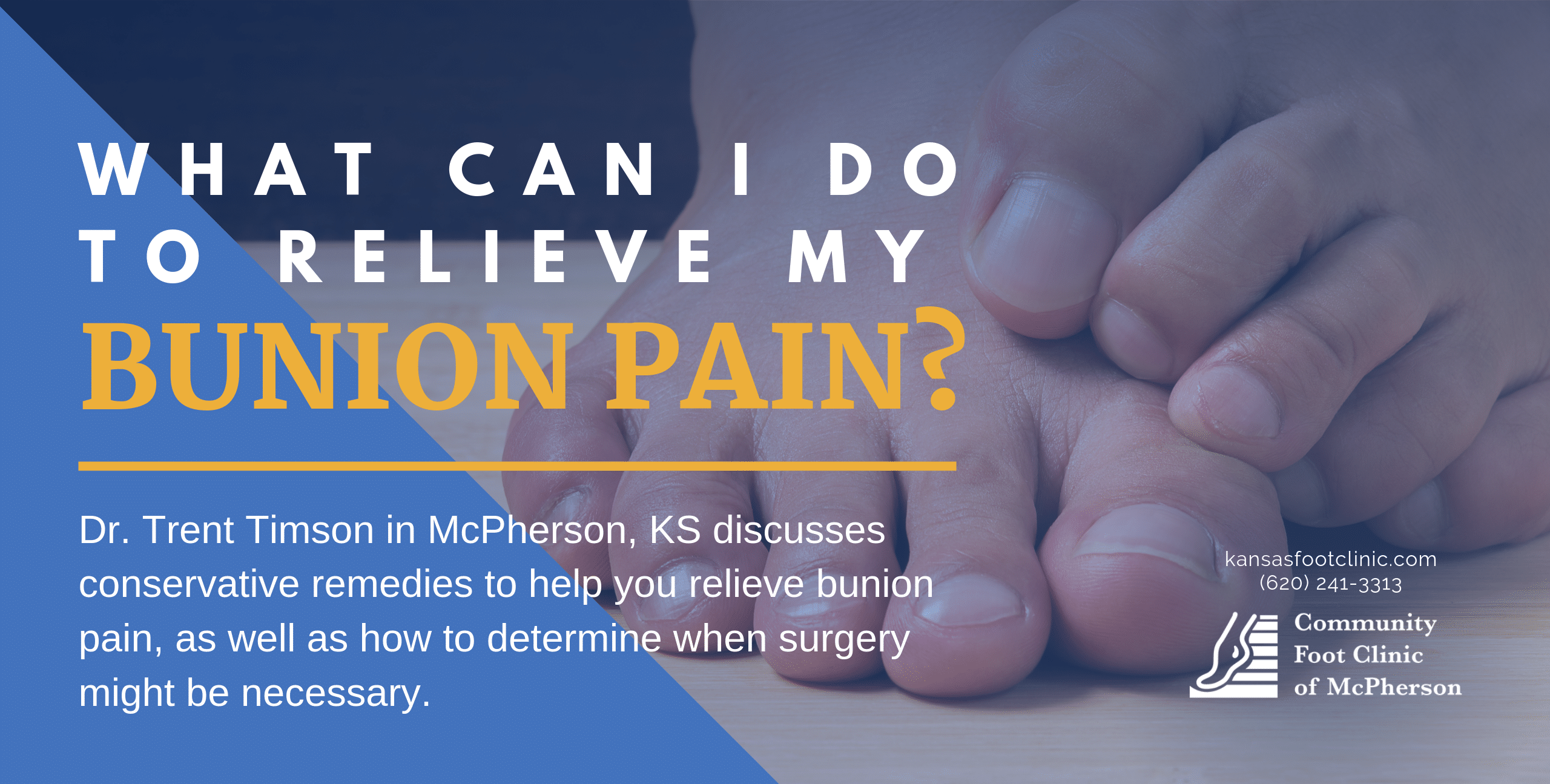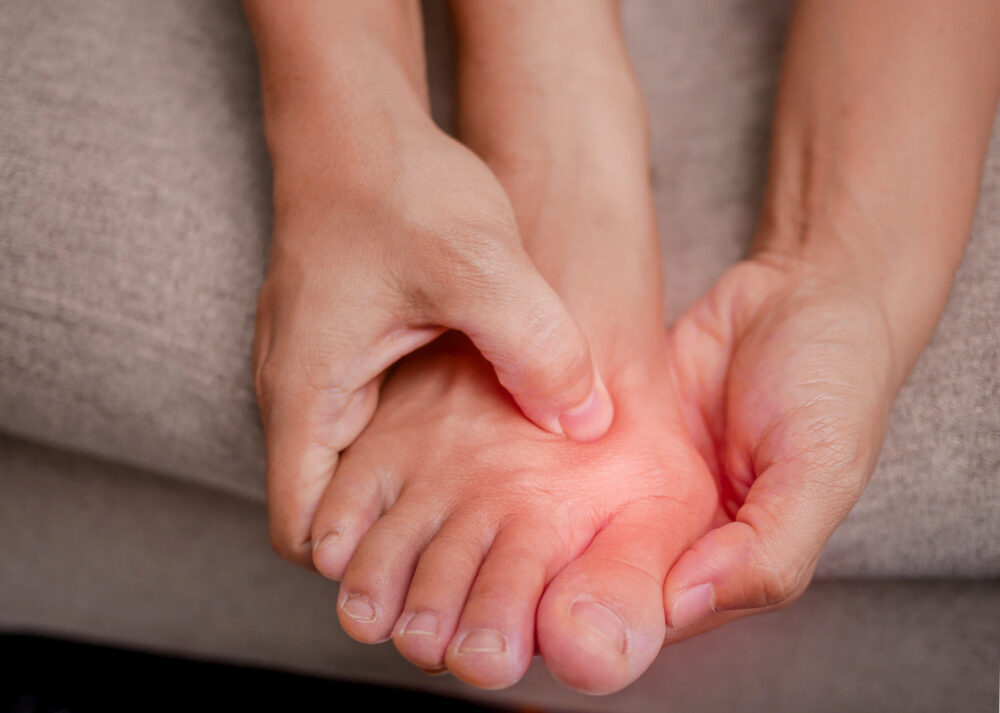What Can I Do to Relieve My Bunion Pain?
Bunion pain is one of those things in life that you wouldn’t wish on anybody, let alone yourself. It can be debilitating to deal with, and can even diminish your quality of life. Necessary daily tasks may become deeply unpleasant to perform. Hobbies you used to participate in regularly may become too painful to enjoy at all.
And if the bump at the base of your big toe isn’t causing you too much discomfort yet, just know this: without taking action now, it will.
Understanding bunions, what causes them, and how to manage the pain can help you take control of your foot health. In this article, we’ll discuss what bunions are, how to recognize them, and how to manage the pain at home. We’ll also explore when it’s time to seek professional help.
What is a Bunion?
Besides being painful and unsightly, bunions can be defined as a type of deformity that develops on the metatarsophalangeal (MTP) joint at the base of the big toe. The bony bump occurs as a result of prolonged pressure on the foot, often from wearing tight, narrow shoes or high heels.
Bunion symptoms include soreness, swelling, and redness in the affected area of the foot. They can start as mild, but will always worsen over time. Unfortunately, many people wait until symptoms become severe before reaching out for help. Not only is this unnecessary – there are plenty of ways to mitigate bunion pain – but it also increases their chances of needing surgery.
How Bad is Your Bunion?
Bunions are progressive deformities that only ever stagnate or get worse over time—never better—so getting your pain under control as soon as possible should be your highest priority.
That’s because the further along your bunion has progressed, the fewer good options you’ll have left to manage or relieve your pain. By the time the bunion becomes large and the pain is intense and occurring daily, the “window” on conservative treatment options may already be closed.
In other words, the severity of your bunion determines what pain relief options we’ll be able to recommend for you.
Tips on Managing the Pain at Home
If you believe you have a bunion, don’t wait and hope it goes away on its own. The most impactful step you can take is to address the symptoms head-on. Our goal is always to enable you to manage your pain and pursue your daily activities and hobbies as long as possible without surgery. Depending on the stage your bunion is in, we may be able to recommend some or all of the following options:
- Maintain a healthy weight: Extra pressure on the foot will only exacerbate bunion pain. Eating a healthy diet and exercising can help keep your weight in check and minimize strain on the toes.
- Wear shoes that fit: Shoes should provide adequate space for all your toes, without rubbing against the bunion or squeezing them. As the bunion gets bigger, it’ll get harder and harder to find any pair of shoes that will fit comfortably. So as soon as you can, make sure you’re wearing comfy shoes that leave plenty of room in the forefoot and toe box area to accommodate your bunion, as well as provide lots of wiggle room for your toes.
- Protect the bunion: Even in a roomier pair of shoes, the bunion bump may be prone to rubbing painfully against the inside of the shoe. Wearing good socks will help a lot, but you may also benefit from a nonmedicated bunion pad to reduce friction further. Moleskin or gel-filled pads can also be bought at your local drugstore and worn inside the shoe to provide cushioning, relieve rubbing, and reduce friction.
- Use arch supports or orthotics: Both over-the-counter and custom orthotics can be helpful solutions to reduce pressure and redistribute weight on the bunion area. In many cases, fundamental flaws in foot structure or gait mechanics are a factor in both causing bunions and accelerating their progression. Properly chosen insole or orthotics may help eliminate that underlying source of instability. Plus, the added support and cushioning can help you deal with pain and pressure in the immediate term.
- Wear a splint at night (with a doctor’s approval): Wearing a splint at night helps minimize bunion pain, as it keeps your big toe in proper alignment. As bunions progress, the toe joint becomes progressively more arthritic and rigid, making these options less workable. However, if your toe is still fairly flexible, you may be able to tape your toe back into the correct position. This won’t get rid of the bunion, of course, but it can relieve joint stress and make you more comfortable.
- Take OTC nonsteroidal anti-inflammatory medications: Ibuprofen and other anti-inflammatory medications can help reduce swelling and discomfort associated with bunions. Now, we do not recommend that you be on a daily painkilling regimen to deal with your bunions—if the pain is that bad or that constant, surgery is usually the better solution. However, if the pain is only mild or intermittent, taking an over-the-counter NSAID or, occasionally, stopping by our office for injection therapy may be advisable.
- Apply a topical relief: Use warm soaks, ice packs, and massages to help alleviate pain in the affected area.
- Stretching: The scientific literature is mixed on whether or not stretches or physical therapy are effective for managing bunions. However, they can’t hurt! You may find that stretching and massage help you reduce pain, and it may even help slow the rate at which your bunion progresses by strengthening those supporting muscles and tissues.
What if I am Still in Pain?
If home remedies are not providing adequate relief, or you notice a significant increase in pain or swelling, it’s time to seek professional help. Our podiatrist can provide a thorough assessment of your condition and recommend the best course of action – whether that be orthotics, custom shoes, or even bunion removal surgery.
We know … this isn’t exactly what you wanted to hear. But there are a few things you should know.
First, bunion surgery is highly successful on average. It’s a procedure we perform every week in our office, and the vast majority (over 90 percent) of patients are highly satisfied with the long-term results.
Second, the downtime may be easier than you think. Now, certainly, everyone responds a little differently to the procedure. But it’s not at all unusual for some patients to be back to walking and bearing weight (with a surgical shoe) within a few days of the surgery—some even the same day. Full recovery can be as quick as 2 weeks or as long as about 8, depending on several factors, with perhaps some moderate pain or swelling persisting for a few more months.
And third, while we know surgery can be scary and rehab is never exactly “fun,” if we’re even recommending it in the first place you’re probably already suffering daily. You can either keep suffering indefinitely or take a “chance” on a procedure that is highly likely to fix your deformity and relieve your pain within one to two months.
Bunions are no fun. Take the first step in treating yours by contacting the Community Foot Clinic of McPherson. Our team of specialists will work with you to develop a customized plan that works best for your needs and lifestyle.
If you start to notice a bunion forming at the base of your big toe—regardless of whether your symptoms are mild, extreme, or nonexistent—please call our office immediately for a full examination and treatment options. The earlier you get a bunion evaluated, the more options you have for treating it.
You can schedule with our office in McPherson by dialing (620) 241-3313 today, or simply fill out our online contact form and a member of our staff will reach out to you. Take the first step in treating your bunion today.
© Community Foot Clinic of McPherson. All Rights Reserved.
Privacy Policy | Terms & Conditions
Web Design by CP Solutions
Marketed by VMD Services


